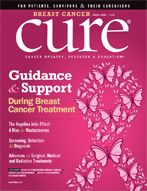Publication
Article
CURE
A Worthwhile Investment
Author(s):
Receiving a cancer diagnosis is a turning point, a moment at which patients need to start determining what seems like the right treatment path and exerting their best efforts to make it happen.
Patients with breast cancer are responsible for making numerous decisions about their own care, but at no time in the process are they more in the hot seat than just after diagnosis. We hope that this issue of CURE magazine will arm you with information that can help — but there are also many other resources available to you.
Receiving a cancer diagnosis is a turning point, a moment at which patients need to start determining what seems like the right treatment path and exerting their best efforts to make it happen.
In the whirlwind after diagnosis, emotions can be highly charged, and it’s often difficult for patients even to focus on what their doctors are saying, let alone to gather information about their disease or treatment plans. Yet patients with breast cancer need to quickly become effective partners in decision-making. How can they arm themselves with the facts and ask the questions that will lead to high-quality decisions that reflect the best evidence and their preferences, choices with which they will be satisfied long-term?
As a newly diagnosed patient, or following surgery for breast cancer, you will naturally have questions. Ask them! Ask your surgeon or medical oncologist about the stage, grade and subtype of your breast cancer and the treatments that are recommended. For each treatment, ask about the expected benefit — in terms of lowering the risks of recurrence or progression — and the anticipated short-term and long-term side effects of the complex array of possible surgical, medical and radiation treatment options. Let your care team know how you like to make decisions and whether you prefer granular statistics or a broader overview of your case to help you understand the choices. Use their expertise and experience to guide you on a course of action — but don’t be afraid to question and challenge as you need to, in order to ensure that your understanding is clear. Seek clarification over the phone or with a second visit, if needed.
Next, turn to sources besides your doctor by seeking a second opinion and/or gathering information from some reliable and well-organized websites, such as the National Cancer Institute (cancer.gov), the American Society of Clinical Oncology (cancer.net), the National Comprehensive Cancer Network (nccn.org/patients) and the American Cancer Society (cancer.org).
Your goal is to understand the underlying risk of recurrence with no therapy and the amount by which a treatment will lower it quantitatively. Even though there’s a lot of variability in outcomes, this will provide you with an estimate that you can then weigh against expected side effects, as well as personal preferences. For example, the very small possibility of long-term neuropathy from paclitaxel may not be worth a 5 percent drop in recurrence risk for someone who enjoys playing the piano. Similarly, specific issues may affect whether one might go with more conservative or aggressive surgery. In this magazine, you will review both medical facts and patients’ own perspectives — both part of the fabric of making sound choices.
Helping to shape your own treatment plan may make you feel more hopeful, not only because you’ll know that the strategy is well-suited to your needs, but because these decisions will banish some of your uncertainty about what to expect in the weeks and months ahead. Do your best to keep a clear head and recruit help from loved ones, if necessary, as you direct your attention to learning about treatments that might be right for you. It’s a worthwhile investment of time. C Debu Tripathy, MDEditor-in-ChiefProfessor of MedicineChair, Department of Breast Medical OncologyThe University of Texas MD Anderson Cancer Center





